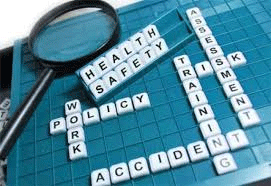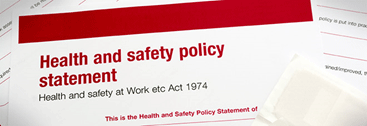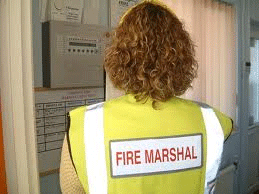How well is your company doing with compliance?

The need for complying with Health and Safety is becoming more and more important, and fines for non-compliance getting higher. Health and safety law states that organisations must:
- assess risks to employees, customers, partners and any other people who could be affected by their activities
- arrange for the effective planning, organisation, control, monitoring and review of preventive and protective measures
- have a written health and safety policy if they employ five or more people
- ensure they have access to competent health and safety advice
- consult employees about their risks at work and current preventive and protective measures.
Failure to comply with these requirements can have serious consequences – for both organisations and individuals. Sanctions include fines, imprisonment and disqualification.
So this week I thought I’d ask “How well is your company doing with compliance?”
The two HSE cases this week both look at tragic accidents that shouldn’t have happened
- John Stoddart, 42, was pulled into the machinery causing fatal injuries.
- A South-West housing firm have been sentenced after capping off a chimney at one of their occupied properties, despite the chimney being in use.
As ever, if you have a subject that you would like us to cover one week, please contact us by phone 01458 253682, email or via our Facebook page or by Twitter.
How well is your company doing with compliance?
Health and safety law states that organisations must:
- assess risks to employees, customers, partners and any other people who could be affected by their activities
- arrange for the effective planning, organisation, control, monitoring and review of preventive and protective measures
- have a written health and safety policy if they employ five or more people
- ensure they have access to competent health and safety advice
- consult employees about their risks at work and current preventive and protective measures.
So let’s look at each of these headings and consider how well you are doing
Assess risks to employees, customers, partners and any other people who could be affected by their activities;
Regulation 3 of the Management of Health and Safety at Work Regulations 1999 clearly states that.
Every employer shall make a suitable and sufficient assessment of—
- the risks to the health and safety of his employees to which they are exposed whilst they are at work; and
- the risks to the health and safety of persons not in his employment arising out of or in connection with the conduct by him of his undertaking.
Every self-employed person shall make a suitable and sufficient assessment of—
- the risks to his own health and safety to which he is exposed whilst he is at work;
- the risks to the health and safety of persons not in his employment arising out of or in connection with the conduct by him of his undertaking.
So I ask; Have you, as an employer or self-employed person,
- Carried out ALL the risk assessments for you and your business?
- Have you made sure that your employees understand them and any control measures that may be required?
- Have your employees signed to confirm their understanding of them?
- Do you have a system in place for making sure that these assessments are up dated and still applicable?
Arrange for the effective planning, organisation, control, monitoring and review of preventive and protective measures;
 Much of our current safety legislation, (The Management of Health and Safety at Work Regulations 1999 and the Construction (Design & Management) Regulations 2015 to name two) place a lot of emphasis on planning, organizing, controlling and monitoring health and safety.
Much of our current safety legislation, (The Management of Health and Safety at Work Regulations 1999 and the Construction (Design & Management) Regulations 2015 to name two) place a lot of emphasis on planning, organizing, controlling and monitoring health and safety.
Sadly though, too many companies fail to do any of these things. I have visited companies where there has been no real planning or organisation with regards to health and safety, it just sort of “happens” and “fits in” where it can!
Many of these companies can boast a good safety record as they haven’t had many accidents. But that isn’t good enough!!
By not really planning or organising safety, you are running a business with an accident waiting to happen and, if and when that accident happens the consequences are likely to be severe for the injured party/ies and the HSE would find it very easy to “throw the book at you” which could result in a large fine and/or imprisonment.
One of the changes under the CDM 2015 regs, requires a construction phase plan to be drawn up for every job including small and domestic works. This is something many smaller builders have never had to do before, I recently showed a small builder how to do this and gave him a simple checklist of questions to follow. A few days later he asked me a check over a plan he had written for a small job he had to do. It was only a page or two in length, which was more than ample and he had done it well. One of the things he told me was “going through this checklist really got me thinking about things and I realized other risks that I may have missed before. Consequently I was able to put in sensible controls for these risks as well”
Having now thought about the planning and controls, you must monitor things. It is only by monitoring that you can see if the controls are working, the employees are following the controls etc. You may also see ways to improve things, thereby making your life easier, safer and hopefully more profitable.
Have a written health and safety policy if they employ five or more people;
Describing how you will manage health and safety in your business will let your staff and others know about your commitment to health and safety. This will be your health and safety policy. It should clearly say who does what, when and how.
 If you have fewer than five employees you don’t have to write down your health and safety policy.
If you have fewer than five employees you don’t have to write down your health and safety policy.
The policy does not need to be complicated or time-consuming. The policy should cover all aspects of the organisation and be relevant to all employees.
A policy statement should consist of three parts:
A general statement of intent –
This should outline in broad terms the organisation’s overall philosophy in relation to the management of health and safety, including reference to the broad responsibilities of both management and workforce.
Organisation (people and their duties) –
This outlines the chain of command in terms of health and safety management, e.g:
- Who is responsible to whom and for what?
- How is the accountability fixed so as to ensure that delegated responsibilities are undertaken?
- How is the policy implementation monitored?
Other organisational features should include:
- Individual job descriptions having a safety content.
- Details of specific safety responsibilities.
- The role and function of safety committee(s).
- The role and function of safety representatives.
- A management chart clearly showing the lines of responsibility and accountability in terms of health and safety management.
Arrangements (systems and procedures) –
This part of the policy deals with the practical arrangements by which the policy will be effectively implemented. These include for example:
- Safety training; Safe systems of work.
- Environmental control; Safe place of work.
- Machine/area guarding; Housekeeping.
- Safe plant and equipment; Noise control.
- Radiation safety; Dust control.
- Use of toxic materials; Internal communication/participation.
- Utilisation of safety committee(s) and safety representatives.
- Fire safety and prevention; Medical facilities and welfare.
- Maintenance of records; Accident reporting and investigation.
- Emergency procedures; Workplace monitoring.
- Employees must be aware of the policy and its contents, in particular they must understand the arrangements which affect them and what their own responsibilities might be. They may be given their own copy (for example, within an employee handbook), or the policy might be displayed around the workplace. With regard to some arrangements, detailed briefings may be necessary, for example as part of induction training.
Employers must revise their policies as often ‘as may be appropriate’. Larger employers are likely to need to arrange for formal review and, where necessary, for revision to take place on a regular basis.
Dating the policy document is an important part of this process
Ensure they have access to competent health and safety advice;
Regulation 7 of the Management of Health & Safety at Work Regulations 1999 states:
Every employer shall, subject to paragraphs (6) and (7),
- (1)Appoint one or more competent persons to assist him in undertaking the measures he needs to take to comply with the requirements and prohibitions imposed upon him by or under the relevant statutory provisions and by Part II of the Fire Precautions (Workplace) Regulations 1997.
- (2)Where an employer appoints persons in accordance with paragraph (1), he shall make arrangements for ensuring adequate co-operation between them.
A person shall be regarded as competent for the purposes of these regulations where he has sufficient training and experience or knowledge and other qualities to enable him properly to assist in undertaking the measures referred to in paragraph (1).
If you haven’t got such a suitably qualified person in your company, and most small companies haven’t, you must appoint an external safety consultancy to help you with this. We at The Wilkins Safety Group have put together a Competent Persons Package to help you comply with this duty.
Consult employees about their risks at work and current preventive and protective measures.
So you have thought about the planning and organisation of health and safety at your business. You have written the risk assessments and health and safety policy and you have appointed a competent person to advise you but it doesn’t stop there.
Have you made sure that your employees have been consulted about these things? Evidence has proved that, if you consult with your employees about safety matters, they will become more responsive to your controls and they may even point out additional risks and recommend sensible control measures as well. But you must involve them.
You must also induct any new person, be they employee or visitor, to your place of work BEFORE they are allowed to wander around and possibly come to harm.
Again sadly, this doesn’t happen as often as it should and I have often been on say, building sites where few to none have been inducted. If you are a construction professional such as an Architect or Surveyor, can you honestly say that you have received site induction on all the sites you visit? I expect the answer is no, but it should be yes.
Whether you are a site foreman, a factory manager or you run a small commercial business, you must ensure that visitors to the site are suitably inducted and aware of the risks and safety controls in place.
Of course your main visitors may well be members of the public, customers etc. and whilst these do not need to be inducted, they do need to be monitored by staff and there must be enough suitable signs, such as fire exit signs, to guide them to safety.
Other Considerations
- Have you got enough suitable trained First Aiders and are there enough suitably stocked first aid kits in your workplace.
- Have you suitably trained Fire Marshals as well as enough fire extinguishers, fire alarm system (may just be a hand held bell or hooter) and suitably marked fire escape routes and muster point.
- Have users of PCs and Laptops been properly “DSE assessed”
- Have all members of your workforce received the correct training in Health & Safety? This may range from general safety awareness for everyone, manual handling, COSHH to Safety Management courses for company bosses and managers.
If you have any questions about this or any other safety topic then Please contact us by phone 01458 253682 or email for more information and assistance.
Training Courses
We have one course already arranged for September but there will be more to come so please keep watching.
These will include a 3 day Safety Management course for all owners and/or directors of SMEs
And our new 3 day APS Accredited 3 Day Course in “The Management of Pre-Construction Health and Safety (2015)” – This 3 day course is suitable for those who wish to act as CDM advisors to Clients, Principle Designers and Contractors or Construction Safety Practitioners
The following are courses already arranged for early September
CDM Regulations 2015 – for the Smaller Builder – half day course
ONLY A FEW PLACES LEFT – BOOK NOW TO AVOID DISAPPOINTMENT
Course Objective:
The Construction (Design and Management) Regulations 2015 (CDM 2015) come into force on the 6th of April 2015, and will apply to all construction projects in the UK incl. Domestic projects
This CDM 2015 awareness training course has been developed to provide smaller builders and tradesmen, especially those who haven’t dealt with CDM before, with an understanding of their role and responsibilities under CDM 2015.
Seminar Outline:
- Introduction to CDM 2015

- Domestic Client Duties
- Principal Designer Duties
- Designer Duties
- Principal Contractor Duties
- Sub-Contractor Duties
- CDM Documentation
- Benefits of Attending
This course give an overview of the requirements for smaller builders and domestic clients and how the regulations apply to all construction projects from minor repairs and decorating works through to building a new house for a domestic client.
Course Duration:
1/2 day
| COURSE REF | DATE(s) | LOCATION |
|---|---|---|
| CDM2015 1507 | Tuesday 8th September | Taunton Racecourse,Orchard Portman,Taunton,Somerset,TA3 7BL |
Fee: £80 to include Course notes, Coffee on arrival & mid-morning refreshments and a Certificate of Training (Fee subject to VAT)
For more information and to book and pay on line please visit our training page.
If you have any questions about these courses or any other training or would like us to run a particular course for you, call Jon Wilkins of the Wilkins Safety Group on 01458 253682 or email him.

Your Business is Safer in Our Hands

